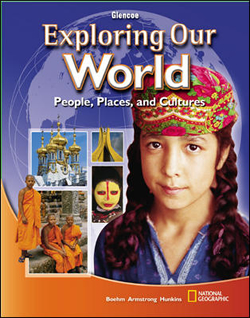Exploring Our World: People, Places, and CulturesChapter 5:
History and Cultures of the United States and CanadaWeb Activity Lesson PlansIntroduction
In this chapter, students have learned that Canada and the United States share similar histories. Both have democratic governments, yet they are organized differently. Both countries have large landforms which are divided into economic and geographic regions. These regions are all rich in natural and human resources and have developed varied and unique cultures based on the resources available to them. Canada’s northern indigenous people, the Inuit, enjoy self-rule in the territory of Nunavut, yet remain a part of Canada. Lesson Description
Students will visit the Official Canadian Government Web site where they will watch a video presentation by an Inuit man as he explains a cultural symbol of his people.
The presenter accompanies the lecture with native drumming and a brief introduction to the sound of the native language. Instructional Objectives - Students will be able to define and describe an Inuksuk.
- Students will be able to explain the traditional importance of an Inuksuk to the Inuit people.
- Students will be able to explain the modern and symbolic significance of an Inuksuk to the Inuit.
Student Web Activity Answers
- likeness of a person
- rocks and stones
- They were used to show hunters and travelers the way home, to mark dangerous places, to show where food was stored, to mark the place where a significant event occurred, and to provide cover for caribou hunters.
- leadership or cooperation
 | 




